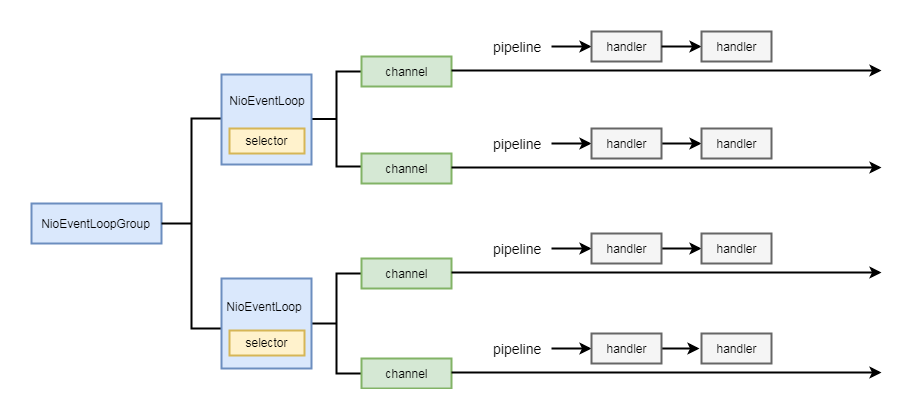这篇文章主要介绍了Netty分布式客户端处理接入事件handle的示例分析,具有一定借鉴价值,感兴趣的朋友可以参考下,希望大家阅读完这篇文章之后大有收获,下面让小编带着大家一起了解一下。
回到上一章NioEventLoop的processSelectedKey ()方法
private void processSelectedKey(SelectionKey k, AbstractNioChannel ch) {
//获取到channel中的unsafe
final AbstractNioChannel.NioUnsafe unsafe = ch.unsafe();
//如果这个key不是合法的, 说明这个channel可能有问题
if (!k.isValid()) {
//代码省略
}
try {
//如果是合法的, 拿到key的io事件
int readyOps = k.readyOps();
//链接事件
if ((readyOps & SelectionKey.OP_CONNECT) != 0) {
int ops = k.interestOps();
ops &= ~SelectionKey.OP_CONNECT;
k.interestOps(ops);
unsafe.finishConnect();
}
//写事件
if ((readyOps & SelectionKey.OP_WRITE) != 0) {
ch.unsafe().forceFlush();
}
//读事件和接受链接事件
//如果当前NioEventLoop是work线程的话, 这里就是op_read事件
//如果是当前NioEventLoop是boss线程的话, 这里就是op_accept事件
if ((readyOps & (SelectionKey.OP_READ | SelectionKey.OP_ACCEPT)) != 0 || readyOps == 0) {
unsafe.read();
if (!ch.isOpen()) {
return;
}
}
} catch (CancelledKeyException ignored) {
unsafe.close(unsafe.voidPromise());
}
}我们看其中的if判断:
if ((readyOps & (SelectionKey.OP_READ | SelectionKey.OP_ACCEPT)) != 0 || readyOps == 0)上一小节我们分析过, 如果当前NioEventLoop是work线程的话, 这里就是op_read事件, 如果是当前NioEventLoop是boss线程的话, 这里就是op_accept事件, 这里我们以boss线程为例进行分析
之前我们讲过, 无论处理op_read事件还是op_accept事件, 都走的unsafe的read()方法, 这里unsafe是通过channel拿到, 我们知道如果是处理accept事件, 这里的channel是NioServerSocketChannel, 这里与之绑定的unsafe是NioMessageUnsafe
我们跟到NioMessageUnsafe的read()方法:
public void read() {
//必须是NioEventLoop方法调用的, 不能通过外部线程调用
assert eventLoop().inEventLoop();
//服务端channel的config
final ChannelConfig config = config();
//服务端channel的pipeline
final ChannelPipeline pipeline = pipeline();
//处理服务端接入的速率
final RecvByteBufAllocator.Handle allocHandle = unsafe().recvBufAllocHandle();
//设置配置
allocHandle.reset(config);
boolean closed = false;
Throwable exception = null;
try {
try {
do {
//创建jdk底层的channel
//readBuf用于临时承载读到链接
int localRead = doReadMessages(readBuf);
if (localRead == 0) {
break;
}
if (localRead < 0) {
closed = true;
break;
}
//分配器将读到的链接进行计数
allocHandle.incMessagesRead(localRead);
//连接数是否超过最大值
} while (allocHandle.continueReading());
} catch (Throwable t) {
exception = t;
}
int size = readBuf.size();
//遍历每一条客户端连接
for (int i = 0; i < size; i ++) {
readPending = false;
//传递事件, 将创建NioSokectChannel进行传递
//最终会调用ServerBootstrap的内部类ServerBootstrapAcceptor的channelRead()方法
pipeline.fireChannelRead(readBuf.get(i));
}
readBuf.clear();
allocHandle.readComplete();
pipeline.fireChannelReadComplete();
//代码省略
} finally {
//代码省略
}
}首先获取与NioServerSocketChannel绑定config和pipeline, config我们上一小节进行分析过, pipeline我们将在下一章进行剖析
我们看这一句:
final RecvByteBufAllocator.Handle allocHandle = unsafe().recvBufAllocHandle();这里通过RecvByteBufAllocator接口调用了其内部接口Handler
public interface RecvByteBufAllocator {
Handle newHandle();
interface Handle {
int guess();
void reset(ChannelConfig config);
void incMessagesRead(int numMessages);
void lastBytesRead(int bytes);
int lastBytesRead();
void attemptedBytesRead(int bytes);
int attemptedBytesRead();
boolean continueReading();
void readComplete();
}
}我们看到RecvByteBufAllocator接口只有一个方法newHandle(), 顾名思义就是用于创建Handle对象的方法, 而Handle中的方法, 才是实际用于操作的方法
在RecvByteBufAllocator实现类中包含Handle的子类, 具体实现关系如下:

回到read()方法中再看这段代码:
final RecvByteBufAllocator.Handle allocHandle = unsafe().recvBufAllocHandle();unsafe()返回当前channel绑定的unsafe对象, recvBufAllocHandle()最终会调用AbstractChannel内部类AbstractUnsafe的recvBufAllocHandle()方法
跟进AbstractUnsafe的recvBufAllocHandle()方法:
public RecvByteBufAllocator.Handle recvBufAllocHandle() {
//如果不存在, 则创建一个recvHandle的实例
if (recvHandle == null) {
recvHandle = config().getRecvByteBufAllocator().newHandle();
}
return recvHandle;
}如果如果是第一次执行到这里, 自身属性recvHandle为空, 会创建一个recvHandle实例, config()返回NioServerSocketChannel绑定的ChannelConfig, getRecvByteBufAllocator()获取其RecvByteBufAllocator对象, 这两部分上一小节剖析过了, 这里通过newHandle()创建一个Handle, 这里会走到AdaptiveRecvByteBufAllocator类中的newHandle()方法中
public Handle newHandle() {
return new HandleImpl(minIndex, maxIndex, initial);
}这里创建HandleImpl传入了三个参数, 这三个参数我们上一小节剖析过, minIndex为最小内存在SIZE_TABLE中的下标, maxIndex为最大内存在SEIZE_TABEL中的下标, initial是初始内存, 我们跟到HandleImpl的构造方法中:
public HandleImpl(int minIndex, int maxIndex, int initial) {
this.minIndex = minIndex;
this.maxIndex = maxIndex;
index = getSizeTableIndex(initial);
nextReceiveBufferSize = SIZE_TABLE[index];
}初始化minIndex和maxIndex, 根据initial找到当前的下标, nextReceiveBufferSize是根据当前的下标找到对应的内存
这样, 我们就创建了个Handle对象
在这里我们需要知道, 这个handle, 是和channel唯一绑定的属性, 而AdaptiveRecvByteBufAllocator对象是和ChannelConfig对象唯一绑定的, 间接也是和channel进行唯一绑定
public void read() {
//必须是NioEventLoop方法调用的, 不能通过外部线程调用
assert eventLoop().inEventLoop();
//服务端channel的config
final ChannelConfig config = config();
//服务端channel的pipeline
final ChannelPipeline pipeline = pipeline();
//处理服务端接入的速率
final RecvByteBufAllocator.Handle allocHandle = unsafe().recvBufAllocHandle();
//设置配置
allocHandle.reset(config);
boolean closed = false;
Throwable exception = null;
try {
try {
do {
//创建jdk底层的channel
//readBuf用于临时承载读到链接
int localRead = doReadMessages(readBuf);
if (localRead == 0) {
break;
}
if (localRead < 0) {
closed = true;
break;
}
//分配器将读到的链接进行计数
allocHandle.incMessagesRead(localRead);
//连接数是否超过最大值
} while (allocHandle.continueReading());
} catch (Throwable t) {
exception = t;
}
int size = readBuf.size();
//遍历每一条客户端连接
for (int i = 0; i < size; i ++) {
readPending = false;
//传递事件, 将创建NioSokectChannel进行传递
//最终会调用ServerBootstrap的内部类ServerBootstrapAcceptor的channelRead()方法
pipeline.fireChannelRead(readBuf.get(i));
}
readBuf.clear();
allocHandle.readComplete();
pipeline.fireChannelReadComplete();
//代码省略
} finally {
//代码省略
}
}继续往下跟:
allocHandle.reset(config);这个段代码是重新设置配置, 也就是将之前的配置信息进行初始化, 最终会走到, DefaultMaxMessagesRecvByteBufAllocator中的内部类MaxMessageHandle的reet中
public void reset(ChannelConfig config) {
this.config = config;
maxMessagePerRead = maxMessagesPerRead();
totalMessages = totalBytesRead = 0;
}这里仅仅对几个属性做了赋值, 简单介绍下这几个属性:
config:当前channelConfig对象
maxMessagePerRead:表示读取消息的时候可以读取几次(循环次数), maxMessagesPerRead()返回的是RecvByteBufAllocator的maxMessagesPerRead属性, 上一小节已经做过剖析
totalMessages:代表目前读循环已经读取的消息个数, 在NIO传输模式下也就是已经执行的循环次数, 这里初始化为0
totalBytesRead:代表目前已经读取到的消息字节总数, 这里同样也初始化为0
我们继续往下走, 这里首先是一个do-while循环, 循环体里通过int localRead = doReadMessages(readBuf)这种方式将读取到的连接数放入到一个List集合中, 这一步我们下一小节再分析, 我们继续往下走:
我们首先看allocHandle.incMessagesRead(localRead)这一步, 这里的localRead表示这次循环往readBuf中放入的连接数, 在Nio模式下这, 如果读取到一条连接会返回1
跟到中的MaxMessageHandle的incMessagesRead(int amt)方法中:
public final void incMessagesRead(int amt) {
totalMessages += amt;
}这里将totalMessages增加amt, 也就是+1
这里totalMessage, 刚才已经剖析过, 在NIO传输模式下也就是已经执行的循环次数, 这里每次执行一次循环都会加一
再去看循环终止条件allocHandle.continueReading()
跟到MaxMessageHandle的continueReading()方法中:
public boolean continueReading() {
//config.isAutoRead()默认返回true
// totalMessages < maxMessagePerRead
//totalMessages代表当前读到的链接, 默认是1
//maxMessagePerRead每一次最大读多少链接(默认16)
return config.isAutoRead() &&
attemptedBytesRead == lastBytesRead &&
totalMessages < maxMessagePerRead &&
totalBytesRead < Integer.MAX_VALUE;
}我们逐个分析判断条件:
config.isAutoRead(): 这里默认为true
attemptedBytesRead == lastBytesRead: 表示本次读取的字节数和最后一次读取的字节数相等, 因为到这里都没有进行字节数组的读取操作, 所以默认都为0, 这里也返回true
totalMessages < maxMessagePerRead
表示当前读取的次数是否小于最大读取次数, 我们知道totalMessages每次循环都会自增, 而maxMessagePerRead默认值为16, 所以这里会限制循环不能超过16次, 也就是最多一次只能读取16条连接
totalBytesRead < Integer.MAX_VALUE
表示读取的字节数不能超过int类型的最大值
感谢你能够认真阅读完这篇文章,希望小编分享的“Netty分布式客户端处理接入事件handle的示例分析”这篇文章对大家有帮助,同时也希望大家多多支持亿速云,关注亿速云行业资讯频道,更多相关知识等着你来学习!
亿速云「云服务器」,即开即用、新一代英特尔至强铂金CPU、三副本存储NVMe SSD云盘,价格低至29元/月。点击查看>>
免责声明:本站发布的内容(图片、视频和文字)以原创、转载和分享为主,文章观点不代表本网站立场,如果涉及侵权请联系站长邮箱:is@yisu.com进行举报,并提供相关证据,一经查实,将立刻删除涉嫌侵权内容。